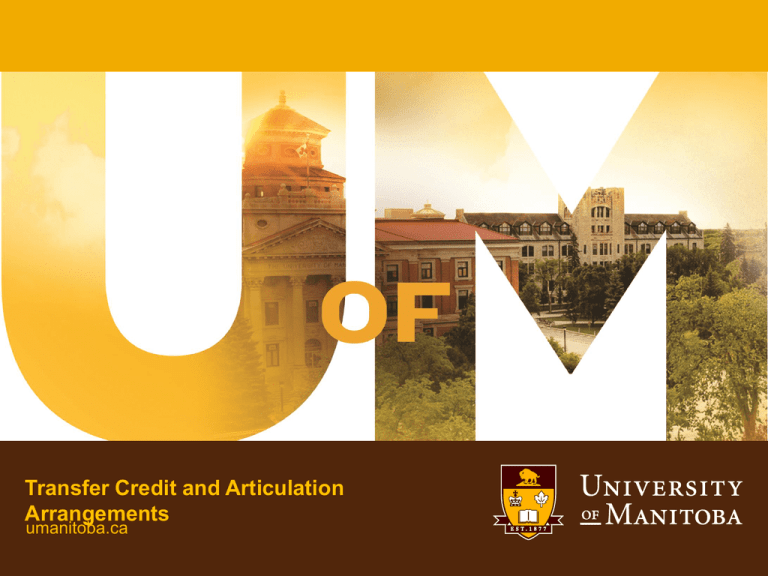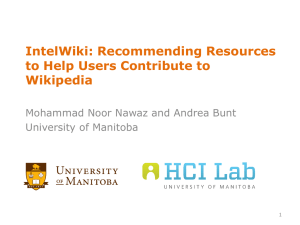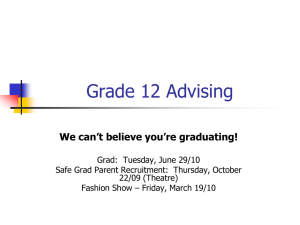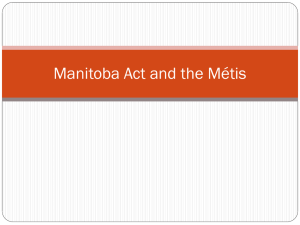University of Manitoba Presentation 2011
advertisement

Transfer Credit and Articulation Arrangements umanitoba.ca Presentation for WestCAT on University of Manitoba Transfer Credit and Articulation Arrangements Thursday, September 22, 2011 Winnipeg, Manitoba Peter Dueck, Executive Director, UM Enrolment Services UM overview by the numbers • • • • • • • • Established 1877; first university in western Canada Fall term 2011 enrolment: 27,992 students 24,236 undergraduate and 3,211 graduate 2,638 international (9.4 percent of total) Over 100 academic programs Over 200 summer research jobs for undergrads 183 exchange programs in 33 countries 95 Rhodes Scholars How UM evaluates transfer credit 1/5 • Transfer credit evaluation for undergraduate programs is part of the admission process • Assessment before a formal admission application can often be accommodated • Students are asked to provide detailed course material issued by their prior institution for any course lacking a current evaluation How UM evaluates transfer credit 2/5 • Credit hours are assigned based on official transcript information, or review of academic year and associated course contact hours • Course material is forwarded to the applicable academic teaching unit for consideration on a course-by-course basis • Course assessments are loaded in the evaluations area to the student record and maintained in our SIS database How UM evaluates transfer credit 3/5 Course evaluations may be assigned one of the following: • Assigned credit: credit granted for a specific course—e.g., PSYC 1200 Introduction to Psychology (6) • Assigned credit with a reduced number of credit hours: e.g., PSYC 1200 Introduction to Psychology (3) • General (unallocated) credit: BIOL 1XXX TRANSFER 1000 LVL (3)—3 credit hours of 1000-level Biology credit • No credit: STAT 9999 NO CREDIT (0)—course has been deemed “no credit” by applicable teaching unit How UM evaluates transfer credit 4/5 • Course assessments are valid for five years before reevaluation is required • Transfer credit policies vary among programs (e.g., some faculties may only consider courses completed within the last ten—or fewer—years) • A similar assessment process is maintained by the Registrar's Office for outgoing ‘letter of permission’ and ‘exchange’ students • All active assessments awarded credit may be viewed at www.umanitoba.ca/admissions/tc How UM evaluates transfer credit 5/5 • Earned grades (Canadian and international) are included on the student record and used in academic standing regulations for most faculties • Established grade tables are consulted, as needed UM transfer credit by the numbers; from fall term 2006 to the present • 36,140 course evaluations completed; more than 6,000 each year • 28,412 of these are currently active • 19,111 have been awarded undergraduate degree level credit; more than 3,000 each year • TCEs have been completed for over 90 countries outside Canada UM course assessments, by province 2006-07 to 2011-12 Canadian jurisdiction 6 yr. total Avg./yr. % of total Manitoba 7268 1211 30.7% Ontario 6017 1003 25.4% Alberta 3951 659 16.7% British Columbia 3367 561 14.2% Saskatchewan 923 154 3.9% Quebec 673 112 2.8% Nova Scotia 602 100 2.5% New Brunswick 435 73 1.8% Newfoundland & Labrador 314 52 1.3% Prince Edward Island 71 12 0.3% Yukon 23 4 0.1% Northwest Territories 1 0 0% UM students with TCEs by faculty total over six years, 2006-07 to 2011-12 Academic unit Academic unit University 1 2558 Kinesiology 140 Arts 2184 Other 117 Science 1375 Agriculture 116 Business 855 Art 105 Nursing 567 Music 78 Engineering 411 Architecture 69 Environment 199 Med. Rehab. 54 Education 190 Pharmacy 50 Human Ecology 170 Law 36 Social Work 145 Dentistry 1 Transfer students 1320 ‘transfers’ admitted for fall 2011 (11.6% of all admits) • 207 University of Winnipeg (15.7% of all transfers) • 121 Red River College (9.2% of all transfers) • 70 Brandon University (5.3% of all transfers) • 60 other Manitoban PSEs (4.5% of all transfers) • 458 total MB PSEs (34.7% of all transfers) • 862 total PSEs in other jurisdictions (65.3% of all transfers) UM New Admits with Transfer Credit 2006-07 to 2010-11, annual averages Academic unit Avg. with transfer credit Avg. total admitted Academic unit Avg. with transfer credit Avg. total admitted University 1 455 5540 Social Work 28 75 Arts 384 1350 Kin & Rec Mgmt 26 164 Science 248 1194 Agric & Food Sci 21 100 Management 172 420 School of Art 21 125 Nursing 111 240 Music 15 75 Engineering 75 330 Env Design 12 100 Environment 41 150 Med Rehab 11 66 Education 37 280 Pharmacy 8 50 Human Ecology 28 154 Law 7 103 Students on Outgoing Exchanges: 2006-7 to 2010-11, average per year, by academic unit Academic Unit Management Arts Science Engineering Environment School of Art Human Ecology Students 37 25 9 8 3 1 1 Credit Hrs 434 268 103 43 41 13 8 Academic Unit Law Agr & Food Sci Env Design Kin & Rec Mgmt Medicine Social Work Students 1 0 0 0 0 0 Credit Hrs 12 5 5 3 2 2 Students on Incoming Exchanges: 2006-7 to 2010-11, average per year, by academic unit Academic Unit Students Academic Unit Students Management 42 Kin & Rec Mgmt 1 Arts 26 Environment 2 Engineering 20 Human Ecology 1 Science 9 Social Work 1 Agr & Food Sci 3 Nursing 1 Env Design 3 Education 1 Law 2 School of Art 0 ‘Outgoing’ Students Studying on a Letter of Permission • • • • 490 students per year (five-year average) 2,883 credit hours per year (five-year average) About 961 single-term courses per year About two single-term courses per student (1.96, on average) ‘Incoming’ Students Studying on a Letter of Permission • 554 students (five-year average) • Most of these are admitted to General Studies, so area of study hard to determine UM transfer credit database www.umanitoba.ca Choose “Current Student” functions Choose “Aurora Student” task Choose “Transfer Credit Equivalencies” Inter-Universities Services (IUS) 1/2 • Mandate: “to deliver university credit courses to residents living north of the 53rd parallel” • Consortium of four MB universities—BU, UM, UW, UCN • UCN handles administration; community volunteers provide support • IUS ensures the transferability of courses that are offered Inter-Universities Services (IUS) 2/2 • Students pick a home university from among consortium members • Students select from courses taught in their home community or by distance • Residency requirements are waived (or considered met) by home university Campus Manitoba 1/4 • “Designed to facilitate access to post-secondary education within the province of Manitoba. Campus Manitoba helps remove the potential barriers of time, geographical location, and to some extent, the cost.” • “CMB reduces barriers to post-secondary education by coordinating the registration of students and the delivery of certificate, diploma and degree courses/programs offered by the participating universities and colleges.” • Campus Manitoba (CMB) is a consortium of Manitoba's publicly funded universities and colleges. • Funded by the MB Council on Post-Secondary Education (COPSE) Campus Manitoba 2/4 • CMB centres are located in various communities across Manitoba. • CMB coordinators provide academic and logistical support for students enrolled in Campus Manitoba. • CMB courses are delivered in two basic formats: live and online. • "Live" lectures are delivered on a predetermined schedule using either iLinc or elluminate, real-time virtual classrooms that enable instructors to deliver live courseware to students and receive feedback via the internet. • "Online" classes are generally accessed using net-based interfaces called Angel, Moodle and WebCT. Lectures are provided online, and can be supplemented by a combination of CDs, videos, printed manuals and posted information. Communication with instructors or other students takes place by email, bulletin boards and at times by phone. Campus Manitoba 3/4 • Q: What is a "home institution"? • A: Despite the virtually seamless transfer of credits, Campus Manitoba students must choose a "home institution". • That institution will evaluate and approve your admission application, hold all your earned credits, and will be the institution from which you expect to graduate. • Your transcripts will be issued by your "home institution". • At the end of your studies, students graduate from their home university or home college ("home institution"), not from Campus Manitoba. • Quoted from http://www.campusmanitoba.com/ Campus Manitoba 4/4 • Q: Are course credits fully transferrable between "home institutions"? • A: All CMB university courses have "course credit equivalency". • If you want to transfer credit from university to college or from college to university, you will need to contact your home institution and talk to a student advisor. In almost all cases, credit transfers are possible. • For example: If you completed a two year Business Administration diploma at Assiniboine Community College (ACC) or Red River College (RRC), you would receive full credit for those courses, if you enrolled in a university business administration degree program. • Quoted from http://www.campusmanitoba.com/ Canadian Virtual University (CVU) www.cvu-uvc.ca • CVU is an association of Canadian universities specializing in online and distance education; member universities include: – – – – – – – – – – – – Athabasca University Carleton University Laurentian University Memorial University of Newfoundland Mount Royal University Nipissing University Royal Military College of Canada Royal Roads University TÉLUQ, l'université à distance de l'UQÀM Thompson Rivers University University of Manitoba University of New Brunswick Prior Learning Assessment (PLAR) An example of PLAR: Certificate in Adult and Continuing Education (CACE) Relevant learning gained outside of the CACE Program may be eligible for credit towards the certificate to a maximum of 125 hours of credit. Recognition of prior learning may occur in several ways: • • • Exemptions/Transfer of Credit Exemptions may be granted against CACE courses for equivalent courses successfully completed and evaluated at recognized institutions. There is a $75 non-refundable fee for each exemption request for courses taken outside of the University of Manitoba and no fee for courses completed at the UM. Prior Learning Assessment and Recognition (PLAR) Recognition of prior learning for credit in the CACE Program may be obtained by submission of evidence of verifiable learning. To be eligible for credit in CACE, learning must be both relevant and equivalent to the content of the CACE Program and be at a university level. The PLA assessment fee is $365. PLA is only an option at the start of the program. Credit for Seminar Study This is an option for those already enrolled in the CACE Program who would like CACE elective credit for a seminar or workshop taken outside of the Program. Approval for seminar credit must be arranged in advance of the seminar. (A statement of learning outcomes, proof of attendance and written assignment are required. The administrative fee for seminar credit is $125 for 20 hours or less and $200 for over 20 hours of credit to a maximum of 40 hours.) Bachelor of Arts Integrated Studies 1/2 • The Bachelor of Arts Integrated Studies (BAIS) is a new degree program offered by the Faculty of Arts • BAIS is for working adults who have completed some postsecondary education and would like to complete an undergraduate degree; Extended Education helped with program development. • The BAIS requires concentrations of study rather than the traditional major/minor approach. These areas of concentration and elective components allow more flexibility in course selection based on interests and needs • The program is 90 credit hours divided into three components: – 21 credit hours of Foundation courses – 18 credit hours of an area of Concentration – 51 credit hours of elective courses BAIS: Admission and TCE 2/2 • The Faculty will consider the completed certificate or diploma programs (listed below) or 24 credit hours of university level course work as the basis of admission even if courses were completed more than 10 years ago • Courses completed at community or junior colleges may also be used as basis for admission and possible transfer credit • Subject to admission and transfer credit conditions, students could expect to receive credit in the four certificate programs as follows: – – – – UM Cert. in Human Resource Management (HRM): 24 credit hours UM Cert. in Adult and Continuing Education (CACE): 18 credit hours UM Cert. in Financial and Management Accounting (FMA): 27 cr. hrs. Canadian Institute of Management Certificate Program in Management and Administration (C.I.M.): 24 credit hours Internationally Trained Professionals • International Dentist Degree Program (IDDP) – After a 7-8 week summer orientation program, students enter the 3rd year of the regular dentistry program on the way to DMD • Internationally Educated Engineers Qualification Program (IEEQ) – University engineering courses, co-op work experience, cultural orientation, language and communication support, and professional networking, over 12 to 24 months; IEEQ completers are considered ’academically qualified’ by APEGM, as part of the process of achieving a P.Eng. license in Manitoba • Internationally Educated Teachers (IET); Internationally Educated Agrologists Pilot (IEAP) Program International College of Manitoba • ICM offers a pathway to an undergraduate degree at the University of Manitoba. • The UTPII programs are the equivalent to the first year of the University's Bachelor Degree; upon successful completion of UTPII, students transfer into the second year of their degree at the University of Manitoba. • To progress to the second year at the University of Manitoba students must successfully complete 30 credit hours of advanced standing, meet minimum GPA requirements, and satisfy other relevant entry requirements. Advanced Standing arrangements • • • • Advanced Placement International Baccalaureate Dual Credit Challenge for Credit Advanced Placement • Admissions Course Requirements – For admission, UM normally uses high school grades received in courses designed to prepare students for A.P. exams—not A.P. results • English Language Proficiency – Students can meet English language proficiency requirement with a grade of four or greater on the A.P. English exam • Scholarships – A.P. students are considered first for regular entrance scholarships – A.P. top-up awards: $250 for each A.P. 5; $150 for each A.P. 4 • University Credit – Students may be granted university level credit for select A.P. results in which they meet the university’s minimum grade requirement (normally four). The university credit must be authorized by the school or faculty to which the student has been admitted as being appropriate for inclusion in that particular degree or diploma program. – Grades conversion: AP 5 plus high school 95% = UM A+; AP 5 = UM A; AP 4 = UM B; AP 3 or less = no credit • • No limit on the maximum amount of credit that can be granted for A.P. results Accepting university credit is voluntary, and students may elect to decline the credit International Baccalaureate • Admissions Course Requirements – Full I.B. diploma: 3 higher level, 3 standard level; min. total grade of 24, min. 4 in each course; specific subject requirements – Without full diploma, individual courses can be considered for admission purposes • English Language Proficiency – A grade of four or greater on the I.B. English exam will meet this requirement • Scholarships – 43-44 points = $2,800; 40-42 = $2,500; 37-39 = $2,200; 34-36 = $1,900; 31-33 = $1,600; 28-30 = $1,300; 25-27 = $1,100 – Top-ups: IB 7HL = $250; IB 6HL = $200; IB 7SL = $200; IB 5HL = $150 • University Credit – IB 7 = UM A+; IB 6 = UM A; IB 5 = UM B+; IB 4 = UM B; IB <=3 = UM no credit – There is no limit on the maximum amount of credit that can be granted for I.B. results – Accepting university credit for IB results is voluntary and students may elect to decline the credit – Students with an IB course that does not appear on ‘the list’ may request a review for transfer credit Dual Credit 1/3 • University-level courses offered to high school students for university and high school credit • Instructors approved by relevant UM department • Reduced fee structure; sometimes fees covered by high school division • Grades available for high school credit and for UM credit Dual Credit 2/3 What are the benefits? • Earn university credit while still in high school • Increased access and future success at university • Wide range of University 1 courses • Variety of learning formats, times and places • Courses eligible for dual credit with university and high school Where can I take courses? • Campus Manitoba centres across the province • Online—anywhere, anytime • Evenings and weekends at various Winnipeg locations Dual Credit 3/3 Eligibility for dual credit courses: student must have … • Completed a minimum of 20 high school credits (inc. English 30S, Mathematics 30S, and one of Geography 30S or History 30S) with an overall average of 80% • OR completed a minimum of 22 high school credits inc. two 40-level courses) with an overall average of 70% • AND a written recommendation of academic ability from the high school principal • AND registered in high school on a full-time or part-time basis Challenge for Credit • Courses are taught in the high schools by a teacher approved by the UM Math department • Students must have a grade of 85% or higher and also be approved by the UM Math department • Assignments worth 10% are given by the high school teacher • The mid-term exam (30%) and the final exam (60%) are taken by the students on UM campus • Students pay the challenge fee (half of course tuition) and do not pay the admission fee. MB articulation arrangements 1/2 Red River College (see http://umanitoba.ca/academic/programs/rrc/) • American Sign Language (Interpretation)—UM: B.A. 4 years (2+2) RRC: Cert. in Deaf Studies, Dipl. In ASL-Eng Interpret • Business Administration—UM: B.Comm. 4 years (2+2) • • • • • • RRC: Dipl. In Business Administration Nursing—UM: B.N. 4 years (3+1) RRC: B.N. Engineering—UM: B. Eng. Credit transfer agreements (case-by-case) RRC: Mech. Eng. Tech. / Elect. Eng. Tech. / Civil/CAD Tech. School of Art—UM: Discussions ongoing RRC: Media Design, Graphic Design & Adv. Graphic Design Diploma Agricultural and Food Sciences—UM: Discussions ongoing RRC: Animal Tech / Environ. Dipl. / Culinary Skills Program Education—UM: B. Ed. Discussions ongoing RRC: Various Social Work—UM: B.S.W. Discussions ongoing RRC: Metis Child, Fam. Serv. Program / Child & Youth Care Diploma MB articulation arrangements 2/2 Assiniboine Community College (ACC) • Business Administration—UM: B.Comm. (Hons.) 4.4 years (2+2.4) ACC: Dipl. In Business Administration • Nursing—UM: B.N. 4 years (3+1), or 5.3 years (2+3.3) ACC: Dipl. Practical Nursing University College of the North (UCN) • Business Administration—UM: B.Comm. (Hons.) 3.65 years (2 +1.65) UCN: Diploma In Business Administration • Chemical Engineering—UM: B.Sc. Variable length UCN: Dipl. Chemical Engineering Technology • Natural Resources Management—UM: B.Sc. (Env. Stud.) 4 years (2+2) UCN: Dipl. In Natural Resources Management Tech. Yellowquill College • Social Work—UM: B.S.W. Discussions ongoing Yellowquill: First Nations Child & Fam. Serv. Dipl. International articulations 1/2 • Called Student Transfer Program Agreements • An agreement that describes the terms and conditions by which students who have completed an approved list of pre-requisite courses of study at another institution may transfer to the University of Manitoba to complete their program of study and receive a UM degree. • Students study for a minimum of 2 academic years at the University of Manitoba on this type of program. • http://wwwapps.cc.umanitoba.ca/international_agreements/types International articulations 2/2 1. 2. 3. 4. 5. 6. 7. 8. 9. 10. 11. 12. 13. 14. 15. Dr. Mahalingam Intl Institute of Technology & Dr. Mahalingam College of Engineering and Technology (Dr. M. Institute) – Engineering Garcha International Institute – Agricultural & Food Sciences, Engineering, Science Guru Ramdass Academy of International Studies Madya Pradesh (GRAIS) – Agricultural & Food Sciences Huazhong Agricultural University – Agricultural & Food Sciences Inner Mongolia Agricultural University – Agricultural & Food Sciences Kyiv National Taras Shevchenko University – Graduate Studies (Department of Mathematics) Management Education and Research Institute, New Delhi – Agricultural & Food Sciences, Science Nanjing Agricultural University – Agricultural & Food Sciences Nanjing University of Finance and Economics – Agricultural & Food Sciences Ningbo University – I.H. Asper School of Business Ningbo University, P.R. China – Engineering Northwest A & F University – Agricultural & Food Sciences Shaoxing University, P.R. China – Engineering St. Xavier's College, Calcutta – Agricultural & Food Sciences, Science UCSI - University College Sedaya International – Engineering, I.H. Asper School of Business











